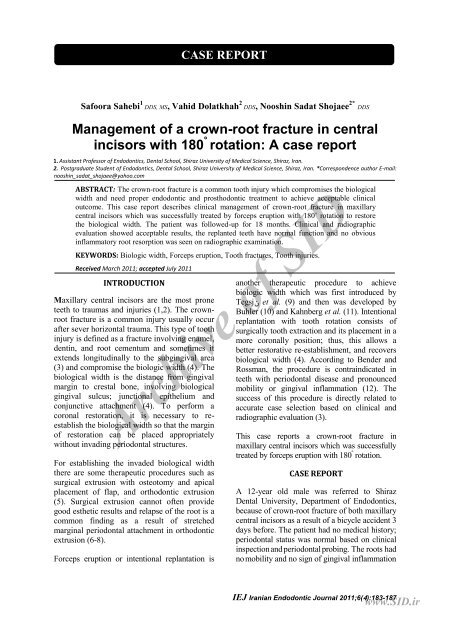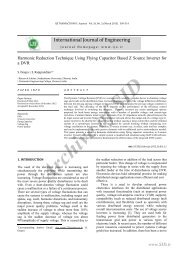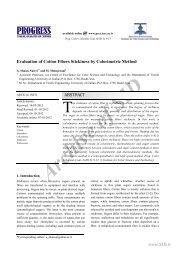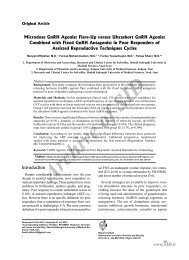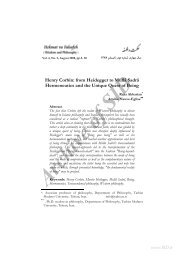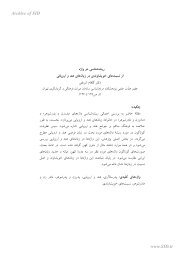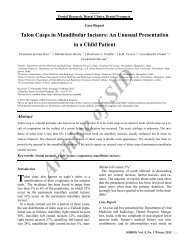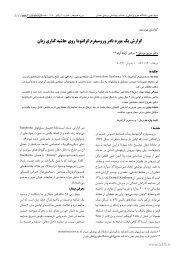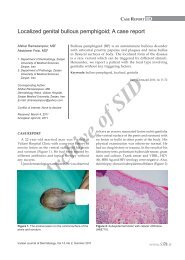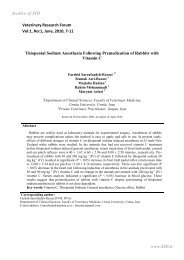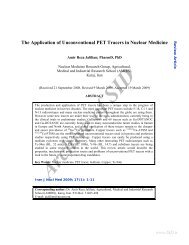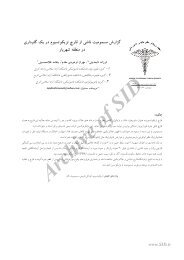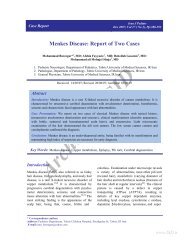Management of a crown-root fracture in central incisors with 180 ...
Management of a crown-root fracture in central incisors with 180 ...
Management of a crown-root fracture in central incisors with 180 ...
You also want an ePaper? Increase the reach of your titles
YUMPU automatically turns print PDFs into web optimized ePapers that Google loves.
CASE REPORT<br />
Safoora Sahebi 1 DDS, MS, Vahid Dolatkhah 2 DDS, Noosh<strong>in</strong> Sadat Shojaee 2* DDS<br />
<strong>Management</strong> <strong>of</strong> a <strong>crown</strong>-<strong>root</strong> <strong>fracture</strong> <strong>in</strong> <strong>central</strong><br />
<strong>in</strong>cisors <strong>with</strong> <strong>180</strong> ° rotation: A case report<br />
1. Assistant Pr<strong>of</strong>essor <strong>of</strong> Endodontics, Dental School, Shiraz University <strong>of</strong> Medical Science, Shiraz, Iran.<br />
2. Postgraduate Student <strong>of</strong> Endodontics, Dental School, Shiraz University <strong>of</strong> Medical Science, Shiraz, Iran. *Correspondence author E-mail:<br />
noosh<strong>in</strong>_sadat_shojaee@yahoo.com<br />
ABSTRACT: The <strong>crown</strong>-<strong>root</strong> <strong>fracture</strong> is a common tooth <strong>in</strong>jury which compromises the biological<br />
width and need proper endodontic and prosthodontic treatment to achieve acceptable cl<strong>in</strong>ical<br />
outcome. This case report describes cl<strong>in</strong>ical management <strong>of</strong> <strong>crown</strong>-<strong>root</strong> <strong>fracture</strong> <strong>in</strong> maxillary<br />
<strong>central</strong> <strong>in</strong>cisors which was successfully treated by forceps eruption <strong>with</strong> <strong>180</strong>˚ rotation to restore<br />
the biological width. The patient was followed-up for 18 months. Cl<strong>in</strong>ical and radiographic<br />
evaluation showed acceptable results, the replanted teeth have normal function and no obvious<br />
<strong>in</strong>flammatory <strong>root</strong> resorption was seen on radiographic exam<strong>in</strong>ation.<br />
KEYWORDS: Biologic width, Forceps eruption, Tooth <strong>fracture</strong>s, Tooth <strong>in</strong>juries.<br />
Received March 2011; accepted July 2011<br />
INTRODUCTION<br />
Maxillary <strong>central</strong> <strong>in</strong>cisors are the most prone<br />
teeth to traumas and <strong>in</strong>juries (1,2). The <strong>crown</strong><strong>root</strong><br />
<strong>fracture</strong> is a common <strong>in</strong>jury usually occur<br />
after sever horizontal trauma. This type <strong>of</strong> tooth<br />
<strong>in</strong>jury is def<strong>in</strong>ed as a <strong>fracture</strong> <strong>in</strong>volv<strong>in</strong>g enamel,<br />
dent<strong>in</strong>, and <strong>root</strong> cementum and sometimes it<br />
extends longitud<strong>in</strong>ally to the subg<strong>in</strong>gival area<br />
(3) and compromise the biologic width (4). The<br />
biological width is the distance from g<strong>in</strong>gival<br />
marg<strong>in</strong> to crestal bone, <strong>in</strong>volv<strong>in</strong>g biological<br />
g<strong>in</strong>gival sulcus; junctional epithelium and<br />
conjunctive attachment (4). To perform a<br />
coronal restoration, it is necessary to reestablish<br />
the biological width so that the marg<strong>in</strong><br />
<strong>of</strong> restoration can be placed appropriately<br />
<strong>with</strong>out <strong>in</strong>vad<strong>in</strong>g periodontal structures.<br />
Archive <strong>of</strong> SID<br />
For establish<strong>in</strong>g the <strong>in</strong>vaded biological width<br />
there are some therapeutic procedures such as<br />
surgical extrusion <strong>with</strong> osteotomy and apical<br />
placement <strong>of</strong> flap, and orthodontic extrusion<br />
(5). Surgical extrusion cannot <strong>of</strong>ten provide<br />
good esthetic results and relapse <strong>of</strong> the <strong>root</strong> is a<br />
common f<strong>in</strong>d<strong>in</strong>g as a result <strong>of</strong> stretched<br />
marg<strong>in</strong>al periodontal attachment <strong>in</strong> orthodontic<br />
extrusion (6-8).<br />
Forceps eruption or <strong>in</strong>tentional replantation is<br />
another therapeutic procedure to achieve<br />
biologic width which was first <strong>in</strong>troduced by<br />
Tegsjö et al. (9) and then was developed by<br />
Buhler (10) and Kahnberg et al. (11). Intentional<br />
replantation <strong>with</strong> tooth rotation consists <strong>of</strong><br />
surgically tooth extraction and its placement <strong>in</strong> a<br />
more coronally position; thus, this allows a<br />
better restorative re-establishment, and recovers<br />
biological width (4). Accord<strong>in</strong>g to Bender and<br />
Rossman, the procedure is contra<strong>in</strong>dicated <strong>in</strong><br />
teeth <strong>with</strong> periodontal disease and pronounced<br />
mobility or g<strong>in</strong>gival <strong>in</strong>flammation (12). The<br />
success <strong>of</strong> this procedure is directly related to<br />
accurate case selection based on cl<strong>in</strong>ical and<br />
radiographic evaluation (3).<br />
This case reports a <strong>crown</strong>-<strong>root</strong> <strong>fracture</strong> <strong>in</strong><br />
maxillary <strong>central</strong> <strong>in</strong>cisors which was successfully<br />
treated by forceps eruption <strong>with</strong> <strong>180</strong> º rotation.<br />
CASE REPORT<br />
A 12-year old male was referred to Shiraz<br />
Dental University, Department <strong>of</strong> Endodontics,<br />
because <strong>of</strong> <strong>crown</strong>-<strong>root</strong> <strong>fracture</strong> <strong>of</strong> both maxillary<br />
<strong>central</strong> <strong>in</strong>cisors as a result <strong>of</strong> a bicycle accident 3<br />
days before. The patient had no medical history;<br />
periodontal status was normal based on cl<strong>in</strong>ical<br />
<strong>in</strong>spection and periodontal prob<strong>in</strong>g. The <strong>root</strong>s had<br />
no mobility and no sign <strong>of</strong> g<strong>in</strong>gival <strong>in</strong>flammation<br />
IEJ Iranian Endodontic Journal 2011;6(4):183-187<br />
www.SID.ir
Forceps eruption �481<br />
Figure 1. A: Maxillary <strong>central</strong> <strong>in</strong>cisors <strong>with</strong> <strong>in</strong>vasion <strong>of</strong> biological width. B: Fractured fragments <strong>of</strong> both teeth. C: Cl<strong>in</strong>ical<br />
view (palatal) after coronal fragment was removed.<br />
Figure 2. A: Radiographic image before treatment B:<br />
Radiographic image after <strong>root</strong> canal therapy<br />
or periodontal attachment loss was detected.<br />
Cl<strong>in</strong>ical and radiographic exam<strong>in</strong>ations<br />
confirmed <strong>crown</strong>-<strong>root</strong> <strong>fracture</strong> (Figure 1A). The<br />
vitality tests on adjacent teeth revealed that teeth<br />
were all <strong>with</strong><strong>in</strong> normal limits. After local<br />
anesthesia the <strong>fracture</strong> fragments were carefully<br />
removed and the dental remnants were<br />
disarticulated (Figure 1B). Delicate <strong>in</strong>spection<br />
revealed that the teeth marg<strong>in</strong>s were placed<br />
subg<strong>in</strong>givally and were extended apically to the<br />
alveolar crest on the l<strong>in</strong>gual side. As we<br />
expected, the pulp <strong>in</strong>jury had been occurred <strong>in</strong><br />
both teeth (Figure 1C). Intra-canal posts were<br />
needed to accomplish good restorations. The<br />
<strong>root</strong> end were mature and developed so that an<br />
effective apical seal was expected (Figure 2).<br />
Root canal therapy was performed on both<br />
teeth. Under isolated condition us<strong>in</strong>g cotton rolls<br />
Archive <strong>of</strong> SID<br />
the <strong>root</strong> canals were prepared. The canal<br />
enlargement was conducted us<strong>in</strong>g Gates Glidden<br />
drills no. 2, 3 (Dentsply, Maillefer, Ballaigues,<br />
Switzerland) and ProTaper rotary <strong>in</strong>struments<br />
(Dentsply, Maillefer, Ballaigues, Switzerland)<br />
accord<strong>in</strong>g to the manufacturer <strong>with</strong> 2.5% NaOCl<br />
irrigation. After chemical and mechanical <strong>root</strong><br />
canal preparation, the canals were dried <strong>with</strong><br />
paper po<strong>in</strong>ts, and then obturated <strong>with</strong> guttapercha<br />
and AH Plus (Dentsply DeTrey GmbH,<br />
Konstanz, Germany) by lateral compaction<br />
technique. Coronal 2mm <strong>of</strong> gutta-percha was<br />
removed <strong>with</strong> a heated plugger to provide<br />
IEJ Iranian Endodontic Journal 2011;6(4):183-187<br />
sufficient space for placement <strong>of</strong> composite<br />
res<strong>in</strong> which was applied as a part <strong>of</strong> spl<strong>in</strong>t. This<br />
2mm plug <strong>of</strong> composite res<strong>in</strong> would also<br />
provide acceptable coronal seal until the<br />
def<strong>in</strong>itive restoration had been placed.<br />
The rotational forceps eruption was used <strong>in</strong> this<br />
case due to extent <strong>of</strong> <strong>fracture</strong> and <strong>with</strong> the<br />
purpose <strong>of</strong> recover<strong>in</strong>g biological width <strong>with</strong> no<br />
damage <strong>of</strong> cl<strong>in</strong>ical <strong>crown</strong>/<strong>root</strong> ratio, and to<br />
have a better restorative re-establishment. The<br />
parents were <strong>in</strong>formed about the risks and<br />
benefits <strong>of</strong> procedure and they assigned the<br />
<strong>in</strong>formed consent authoriz<strong>in</strong>g the procedure.<br />
Teeth luxation was carefully performed <strong>with</strong><br />
rotational motions avoid<strong>in</strong>g excessive<br />
compression <strong>of</strong> the periodontal ligament towards<br />
the alveolar bone. Rotations <strong>with</strong> <strong>180</strong> º provided<br />
adequate recover<strong>in</strong>g <strong>of</strong> the biological width. The<br />
<strong>root</strong>s were <strong>in</strong>spected for any signs <strong>of</strong> crack or<br />
<strong>fracture</strong> along their surface. The <strong>root</strong>s were fixed<br />
<strong>with</strong> orthodontic wire no.5 spl<strong>in</strong>ted and light<br />
cured res<strong>in</strong> was applied from the left lateral<br />
<strong>in</strong>cisor to the right lateral <strong>in</strong>cisor. (Figure 3)<br />
occlusal adjustment was then performed.<br />
The patient was advised to eat a s<strong>of</strong>t diet and<br />
avoid bit<strong>in</strong>g <strong>with</strong> the <strong>in</strong>jured teeth. Antibiotic<br />
(amoxicill<strong>in</strong> 500mg) and 0.2% chlorhexid<strong>in</strong>e<br />
r<strong>in</strong>se were prescribed to prevent <strong>in</strong>fection.<br />
Seventeen days after replantation, slight<br />
mobility was detected and the spl<strong>in</strong>t was<br />
removed. The prob<strong>in</strong>g depths were normal and<br />
re-attachment had been occurred <strong>in</strong> both <strong>of</strong> the<br />
teeth. After 1 month follow-up, acceptable<br />
cl<strong>in</strong>ical sign and symptoms was observed, then<br />
the teeth were restored us<strong>in</strong>g a post and core<br />
<strong>crown</strong> (Figure 4).<br />
The patient was followed-up after 18 months.<br />
Cl<strong>in</strong>ical and radiographic evaluation showed<br />
www.SID.ir
Archive <strong>of</strong> SID<br />
Sahebi et al. �481<br />
Figure 3. A. Cl<strong>in</strong>ical aspect <strong>of</strong> the <strong>180</strong>˚ rotation and semi rigid spl<strong>in</strong>t<strong>in</strong>g. B. Radiography after spl<strong>in</strong>t<strong>in</strong>g. C, D. Cl<strong>in</strong>ical<br />
photography and radiography after post and core restoration<br />
Figure 4. 18 months follow-up, cl<strong>in</strong>ical photography<br />
and radiography shows acceptable esthetic result and<br />
periodontal/periapical status.<br />
acceptable results <strong>in</strong> mobility test, prob<strong>in</strong>g<br />
depth, cl<strong>in</strong>ical attachment level. There were not<br />
any evidence <strong>of</strong> <strong>root</strong> resorption and alveolar<br />
bone <strong>in</strong>tegrity was ma<strong>in</strong>ta<strong>in</strong>ed.<br />
DISCUSSION<br />
The <strong>in</strong>tentional replantation was first performed<br />
by Tegsjö et al. and is <strong>in</strong>dicated <strong>in</strong> cases <strong>of</strong><br />
<strong>crown</strong>-<strong>root</strong> <strong>fracture</strong>s, cervical caries, <strong>root</strong><br />
resorption or perforations (4). Kim et al.<br />
described surgical extrusion procedure <strong>in</strong> which<br />
after gentle luxation <strong>of</strong> the tooth, the position <strong>of</strong><br />
the tooth was adjusted accord<strong>in</strong>g to the new<br />
biologic width (13). They showed that<br />
periodontium can be recovered functionally and<br />
esthetically.<br />
There are limited data on the survival rate <strong>of</strong><br />
<strong>in</strong>tentionally replanted teeth. It is obvious that<br />
<strong>fracture</strong> <strong>of</strong> the teeth or alveolar bone which<br />
lead to miss<strong>in</strong>g <strong>of</strong> teeth is the most concern.<br />
Root resorption, <strong>in</strong>flammatory response or<br />
ankylosis can be seen <strong>in</strong> dental replantation<br />
procedures. Success rate <strong>of</strong> <strong>in</strong>tentional<br />
replantation was reported between 72.0% and<br />
80.6% (12,14). A traumatic handl<strong>in</strong>g and<br />
stabilization <strong>of</strong> the <strong>root</strong> were found to be the<br />
critical po<strong>in</strong>ts for achiev<strong>in</strong>g good results (15).<br />
Kahnberg (15) demonstrated excellent 5 years<br />
prognosis for the survival <strong>of</strong> the teeth which<br />
had been treated <strong>with</strong> this method.<br />
Furthermore, complete heal<strong>in</strong>g <strong>of</strong> periodontal<br />
ligament was observed <strong>in</strong> 75% <strong>of</strong> cases. Bender<br />
and Rossman (12) reported success rate <strong>of</strong><br />
80.6% for this procedure <strong>in</strong> cases <strong>of</strong> previously<br />
failed conventional endodontic treatment teeth.<br />
They recommended this method for cases which<br />
are difficult <strong>in</strong> accessibility and when there are<br />
anatomical limitations. They stated contra<strong>in</strong>dication<br />
<strong>of</strong> this method <strong>in</strong> cases <strong>with</strong> high<br />
mobility and g<strong>in</strong>gival <strong>in</strong>flammation. Khayat and<br />
Fatehi demonstrated successful outcomes for<br />
this procedure (16). In this study none <strong>of</strong> the<br />
cases showed ankylosis, abnormal mobility, and<br />
sensitivity to percussion or palpation. PDL<br />
heal<strong>in</strong>g was found <strong>in</strong> 95% <strong>of</strong> cases after 12<br />
months. But authors also suggest further<br />
evaluation <strong>of</strong> the cases.<br />
M<strong>in</strong>imal trauma to periodontal ligament, which<br />
reduces ankylosis and <strong>root</strong> resorption <strong>of</strong> the<br />
tooth, is the most critical factor for success.<br />
When trauma to the PDL fibers is m<strong>in</strong>imal, the<br />
heal<strong>in</strong>g process occurs by cemental heal<strong>in</strong>g<br />
which leads to normal structure <strong>of</strong> the<br />
periodontium. In cases <strong>of</strong> severe trauma the<br />
chance <strong>of</strong> <strong>root</strong> resorption or ankylosis <strong>in</strong>creases<br />
(17). Preserv<strong>in</strong>g sever traumatized tooth, like<br />
<strong>in</strong>trusion or avulsion <strong>with</strong> prolonged extra-oral<br />
time, should be considered <strong>with</strong> caution.<br />
Ankylosis will replace the whole <strong>root</strong> <strong>with</strong><br />
bone, arrest the growth <strong>of</strong> the alveolar process,<br />
then tooth will be <strong>in</strong>fra-occlusion. The worst<br />
outcome is sever bone defect which is very<br />
difficult to recover (18,19). Therefore, if the<br />
possibility <strong>of</strong> ankylosis is high, preserv<strong>in</strong>g the<br />
tooth is not logical.<br />
The time for the re-attachment <strong>of</strong> the PDL fibers<br />
is about two weeks (20). When the procedure is<br />
non-traumatized <strong>in</strong>flammation is m<strong>in</strong>imum;<br />
therefore, PDL cells can differentiate properly<br />
and normal re-attachment can be occurred. An<br />
old animal study <strong>in</strong> which <strong>in</strong>tentional replantation<br />
on dogs performed showed that periodontal<br />
ligament can be re-establish successfully and<br />
teeth can survive permanently (21).<br />
In mak<strong>in</strong>g decisions for treatment <strong>of</strong> these<br />
IEJ Iranian Endodontic Journal 2011;6(4):183-187<br />
www.SID.ir
Forceps eruption �481<br />
teeth, patient age, <strong>root</strong> developmental stage,<br />
patient preference and f<strong>in</strong>al outcome <strong>of</strong> each<br />
treatment option should be considered.<br />
There were some possible options for the<br />
treatment <strong>of</strong> this case: orthodontic force<br />
eruption, surgical <strong>crown</strong> lengthen<strong>in</strong>g <strong>with</strong><br />
osseous surgery, decoronation <strong>of</strong> the teeth and<br />
temporary partial denture, and forceps eruption<br />
(<strong>in</strong>tentional replantation). Among these options,<br />
forceps eruption was selected. Intra-alveolar<br />
transplantation or forceps eruption is a k<strong>in</strong>d <strong>of</strong><br />
<strong>in</strong>tentional replantation which is done <strong>in</strong> cases <strong>of</strong><br />
complicated <strong>crown</strong> <strong>root</strong> <strong>fracture</strong> (9).<br />
Consider<strong>in</strong>g the esthetic importance <strong>in</strong> anterior<br />
part <strong>of</strong> the jaw, treatment <strong>of</strong> the teeth <strong>with</strong> <strong>crown</strong><br />
<strong>root</strong> <strong>fracture</strong>s or deep cervical <strong>root</strong> caries, can be<br />
completed <strong>with</strong> this method, long duration<br />
follow-ups <strong>in</strong>dicated the good long-term<br />
prognosis for these teeth (22). Replantation <strong>of</strong><br />
<strong>fracture</strong>d teeth <strong>with</strong> compromised marg<strong>in</strong>s<br />
below the g<strong>in</strong>gival border or bone can improve<br />
achiev<strong>in</strong>g better periodontal heal<strong>in</strong>g.<br />
Development <strong>of</strong> narrow periodontal pockets<br />
along the <strong>fracture</strong> l<strong>in</strong>e will be avoided (23). In<br />
anterior teeth especially <strong>in</strong> upper jaw when a<br />
deep l<strong>in</strong>gual <strong>crown</strong> <strong>root</strong> <strong>fracture</strong> occurs, tooth<br />
can be rotated towards facial side to achieve a<br />
more accessible coronal position <strong>of</strong> the <strong>fracture</strong><br />
l<strong>in</strong>e. This approach is beneficial for reestablish<strong>in</strong>g<br />
the biologic width and placement <strong>of</strong><br />
permanent restoration (3). In this case, <strong>in</strong>cisors<br />
were rotated <strong>180</strong> º due to the deep <strong>fracture</strong> l<strong>in</strong>e<br />
and satisfactory coronal restorations were<br />
placed. Another reason for this rotation was the<br />
retention <strong>of</strong> the <strong>root</strong> <strong>in</strong> the socket. One <strong>of</strong> the<br />
drawbacks <strong>of</strong> replantation technique is that the<br />
periodontal ligament may fail to attach on the<br />
<strong>root</strong> surface (24), but <strong>in</strong> this case 18 months<br />
follow-up revealed healthy periodontal<br />
Archive <strong>of</strong> SID<br />
attachment <strong>with</strong>out any pocket <strong>in</strong> both teeth. In<br />
this case, forceps eruption was the only possible<br />
choice between the 4 mentioned options.<br />
Orthodontic forced eruption was not a good<br />
option because it could lead <strong>in</strong>to the undesirable<br />
coronal movement <strong>of</strong> marg<strong>in</strong>al g<strong>in</strong>giva and<br />
alveolar bone. On the other hand relapse <strong>of</strong> the<br />
extruded tooth is a major problem which can<br />
compromise the results (16). Additionally, this<br />
procedure is expensive and time consum<strong>in</strong>g.<br />
Surgical <strong>crown</strong> lengthen<strong>in</strong>g <strong>with</strong> apically<br />
positioned flap <strong>in</strong>volves surgical removal <strong>of</strong> the<br />
IEJ Iranian Endodontic Journal 2011;6(4):183-187<br />
marg<strong>in</strong>al g<strong>in</strong>giva; it can lead to undesirable<br />
esthetic results. Perform<strong>in</strong>g this procedure,<br />
especially <strong>in</strong> the anterior <strong>of</strong> the maxilla, should<br />
be done <strong>with</strong> caution. This procedure is<br />
contra<strong>in</strong>dicated <strong>in</strong> patients <strong>with</strong> high exposure <strong>of</strong><br />
g<strong>in</strong>gival marg<strong>in</strong>. Surgical <strong>crown</strong> lengthen<strong>in</strong>g<br />
also requires osteotomy <strong>in</strong> this region and it has<br />
been said that it could cause resorption <strong>of</strong> the<br />
labial cortical plate and could later compromise<br />
the bone configuration for plac<strong>in</strong>g dental<br />
implants (18). Surgical <strong>crown</strong> lengthen<strong>in</strong>g<br />
should be considered <strong>with</strong> caution. If the<br />
prognosis <strong>of</strong> this treatment is questionable, it<br />
should be ruled out.<br />
It should be noted that placement <strong>of</strong> implant<br />
dur<strong>in</strong>g childhood is contra<strong>in</strong>dicated (25). It has<br />
been suggested that the ideal age for implant<br />
placement is at the end <strong>of</strong> alveolar growth (18).<br />
S<strong>in</strong>ce implants act like an ankylosed tooth,<br />
therefore plac<strong>in</strong>g an implant before this period<br />
will lead to <strong>in</strong>fra-occlusion <strong>of</strong> the implant. The<br />
age <strong>of</strong> 18 is an ideal time for placement <strong>of</strong><br />
implant, so consider<strong>in</strong>g the age <strong>of</strong> this patient (11<br />
years old) implant cannot be not a good option.<br />
After remov<strong>in</strong>g the coronal <strong>fracture</strong>d segments<br />
the teeth was evaluated for the amount <strong>of</strong><br />
<strong>crown</strong>/<strong>root</strong> ratio, which is important for<br />
placement <strong>of</strong> the cast post and core restoration.<br />
If the <strong>crown</strong>/<strong>root</strong> ratio was not acceptable, the<br />
<strong>root</strong>s <strong>of</strong> the <strong>fracture</strong>d teeth should be preserved<br />
till 18. S<strong>in</strong>ce the extraction <strong>of</strong> the teeth <strong>in</strong> this<br />
region will lead to 40% to 60% bone loss <strong>in</strong> the<br />
first year, especially <strong>in</strong> the facial part <strong>of</strong> the<br />
alveolar ridge, extraction <strong>of</strong> these <strong>root</strong>s is<br />
contra<strong>in</strong>dicated (26). The preservation <strong>of</strong> the<br />
<strong>root</strong>s until the completion <strong>of</strong> alveolar growth<br />
has been suggested. The coronal part <strong>of</strong> the<br />
<strong>root</strong>s should be blunted <strong>with</strong> a chisel <strong>in</strong>strument<br />
because the sharp edges <strong>of</strong> the tooth will<br />
compromise the heal<strong>in</strong>g process <strong>in</strong> <strong>in</strong>volved<br />
area. Then the <strong>root</strong>s will be covered <strong>with</strong> a<br />
mucoperiosteal flap. The rema<strong>in</strong><strong>in</strong>g <strong>root</strong> will<br />
preserve the labiol<strong>in</strong>gual portion <strong>of</strong> the alveolar<br />
process. When the growth has been completed,<br />
the alveolar structure will be optimal for<br />
implant placement (27,28).<br />
CONCLUSION<br />
Forceps eruption is one <strong>of</strong> the alternative<br />
procedures <strong>in</strong> complicated <strong>crown</strong> <strong>root</strong> <strong>fracture</strong>s <strong>in</strong><br />
order to ma<strong>in</strong>ta<strong>in</strong> the damaged structures at health<br />
www.SID.ir
condition aesthetically and functionally. For<br />
successful treatment, atraumatic extraction<br />
techniques, limited extra-oral time to control<br />
damage <strong>of</strong> the periodontal ligament and<br />
appropriate antibiotic therapy for microbiological<br />
control should be correctly <strong>in</strong>dicated and<br />
performed by dental practitioner <strong>in</strong> well selected<br />
cases. Cl<strong>in</strong>ical and radiographic follow-up should<br />
be carried out for 5 years.<br />
Conflict <strong>of</strong> <strong>in</strong>terest: none declared.<br />
REFERENCES<br />
1. Shulman JD, Peterson J. The association<br />
between <strong>in</strong>cisor trauma and Occlusal characteristics<br />
<strong>in</strong> <strong>in</strong>dividuals 8-50 years <strong>of</strong> age. Dent Traumatology<br />
2004;20:67-74.<br />
2. Caldas AF Jr, Burgos ME. A retrospective study<br />
<strong>of</strong> traumatic dental <strong>in</strong>juries <strong>in</strong> a Brazilian dental<br />
trauma cl<strong>in</strong>ic. Dent traumatology 2001;17:250-3.<br />
3. Far<strong>in</strong>iuk LF, Ferreira EL, Sores<strong>in</strong>i GC, Cavali<br />
AE, Baratto Filho F. Intentional replantation <strong>with</strong><br />
<strong>180</strong> degrees rotation <strong>of</strong> a <strong>crown</strong>-<strong>root</strong> <strong>fracture</strong>: a case<br />
report. Dent traumatology 2003;19:321-5.<br />
4. Bittencourt G.S, Almeida F.X, Rold A.<br />
Intentional replantation <strong>with</strong> tooth rotation as<br />
<strong>in</strong>dication for treatment <strong>of</strong> <strong>crown</strong>-<strong>root</strong> <strong>fracture</strong>s.<br />
Brazilian Journal <strong>of</strong> Dental Traumatology 2009;1:2-6.<br />
5. Mag<strong>in</strong>i R S, Censi J C, Bianch<strong>in</strong>i M A.<br />
Reimplante <strong>in</strong>tencional para tratamento de fissura<br />
longitud<strong>in</strong>al: relato clínico apó s acompanhamento<br />
de um ano. Rev. Bras. Odontology 1997;54:l297-<br />
302.<br />
6. Kozlovsky A, Tal H, Lieberman M. Forced<br />
eruption comb<strong>in</strong>ed <strong>with</strong> g<strong>in</strong>gival fiberotomy. A<br />
technique for cl<strong>in</strong>ical <strong>crown</strong> lengthen<strong>in</strong>g. J Cl<strong>in</strong><br />
Periodontol 1988;15:534-8.<br />
7. Pontoriero R, Celenza F Jr, Ricci G, Carnevale<br />
G. Rapid extrusion <strong>with</strong> fiber resection: a comb<strong>in</strong>ed<br />
orthodontic-periodontic treatment modality. Int J<br />
Periodontics Restorative Dent 1987;7:30-43.<br />
8. Nev<strong>in</strong>s M, Mellonig JT. Cl<strong>in</strong>ical approaches and<br />
Archive <strong>of</strong> SID<br />
evidence <strong>of</strong> success. Periodontal therapy vol 1,<br />
Chicago: Qu<strong>in</strong>tessence1998.<br />
9. Tegsjõ U, Valerius-Olsson H, Olgart K. Intraalveolar<br />
transplantation <strong>of</strong> teeth <strong>with</strong> cervical <strong>root</strong><br />
<strong>fracture</strong>s. Swed Dent J 1978;2:73-82.<br />
10. Buhler H. Intra-alveolar transplantation von<br />
E<strong>in</strong>zel Wurzeln. Qu<strong>in</strong>tessence <strong>in</strong>t 1987;38:1963-70.<br />
11. Kahnberg KE, Warfv<strong>in</strong>ge J, Birgersson B.<br />
Intraalveolar transplantation. (I). The use <strong>of</strong><br />
autologous bone transplants <strong>in</strong> the periapical region.<br />
Int J Oral Surg 1982;11:372-9.<br />
12. Bender IB, Rossman LE. Intentional replantation<br />
<strong>of</strong> endodontic ally treated teeth. Oral Surg Oral Med<br />
Sahebi et al.�481<br />
Oral Pathol 1993;76:623-30.<br />
13. Kim SH, Tramont<strong>in</strong>a V, Passanezi E. A new<br />
approach us<strong>in</strong>g the surgical extrusion procedure as<br />
an alternative for the reestablishment <strong>of</strong> biologic<br />
width. Int J Periodontics Restorative Dent<br />
2004;24:39-45.<br />
14. Raghoebar GM, Viss<strong>in</strong>k A. Results <strong>of</strong><br />
<strong>in</strong>tentional replantation <strong>of</strong> molars. J Oral Maxill<strong>of</strong>ac<br />
Surg 1999;57:240-4.<br />
15. Kahnberg KE. Intraalveolar transplantation <strong>of</strong><br />
teeth <strong>with</strong> <strong>crown</strong>-<strong>root</strong> <strong>fracture</strong>s. J Oral Maxill<strong>of</strong>acial<br />
Surg 1985;43:38-42.<br />
16. Khayat A, Fatehi SH. Cl<strong>in</strong>ical evaluation <strong>of</strong><br />
forceps eruption: Reestablish<strong>in</strong>g biologic width and<br />
restor<strong>in</strong>g no restorable teeth. Iranian Endodontic<br />
Journal 2006;1:1-5.<br />
17. Tsukiboshi M. Auto transplantation <strong>of</strong> teeth:<br />
requirements for predictable success. Dent<br />
Traumatology 2002;18:157-80.<br />
18. Schwartz-Arad D, Lev<strong>in</strong> L, Ashkenazi M.<br />
Treatment options <strong>of</strong> untreatable traumatized<br />
anterior maxillary teeth for future use <strong>of</strong> dental<br />
implantation. Implant Dent 2004;13:120-8.<br />
19. Donaldson M, K<strong>in</strong>irons MJ. Factors affect<strong>in</strong>g<br />
the time <strong>of</strong> onset <strong>of</strong> resorption <strong>in</strong> avulsed and<br />
replanted <strong>in</strong>cisor teeth <strong>in</strong> children. Dent<br />
Traumatology 2001;17:205-9.<br />
20. Andreasen J O. Periodontal heal<strong>in</strong>g after<br />
replantation and auto transplantation <strong>of</strong> <strong>in</strong>cisors <strong>in</strong><br />
monkeys. International Journal <strong>of</strong> Oral Surgery<br />
1981;10:54-61.<br />
21. Sherman P Jr. Intentional replantation <strong>of</strong> teeth <strong>in</strong><br />
dogs and monkeys. J Dent Res 1968;47:1066-71.<br />
22. Kahnberg KE. Intra-alveolar transplantation. I.<br />
A 10-year follow-up <strong>of</strong> a method for surgical<br />
extrusion <strong>of</strong> <strong>root</strong> <strong>fracture</strong>d teeth. Swed Dent J<br />
1996;20:165-72.<br />
23. Kudou Y, Kubota M .Replantation <strong>with</strong><br />
<strong>in</strong>tentional rotation <strong>of</strong> a complete vertically<br />
<strong>fracture</strong>d <strong>root</strong> us<strong>in</strong>g adhesive res<strong>in</strong> cement. Dent<br />
Traumatology 2003;19:115-7.<br />
24. Wang Z, Heffernan M, Vann WF Jr.<br />
<strong>Management</strong> <strong>of</strong> a complicated <strong>crown</strong>-<strong>root</strong> <strong>fracture</strong><br />
<strong>in</strong> a young permanent <strong>in</strong>cisor us<strong>in</strong>g <strong>in</strong>tentional<br />
replantation. Dent Traumatology 2008;24:100-3.<br />
25. Davarpanah M, Mart<strong>in</strong>ez H, Kebir M. Cl<strong>in</strong>ical<br />
Manual <strong>of</strong> Implant Dentistry: Contra<strong>in</strong>dication for<br />
Dental Implants. St. Louis: Qu<strong>in</strong>tessence Publish<strong>in</strong>g<br />
Co Ltd, 2003: pp.1-20.<br />
26. Atwood DA, Coy WA. Cl<strong>in</strong>ical, cephalometric,<br />
and densitometric study <strong>of</strong> reduction <strong>of</strong> residual<br />
ridges. J Prosthet Dent 1971;26:280-95.<br />
27. Ingle J, Bakland L.K , Baumgartnuer J.C: Ingles<br />
Endodontics. 6 th Edition, BC Decker Inc.2008; vol<br />
2: pp 1372-3.<br />
28. Malmgren B. Decoronation: how, why, and<br />
when? J Calif Dent Assoc 2000;28:846-54.<br />
IEJ Iranian Endodontic Journal 2011;6(4):183-187<br />
www.SID.ir


